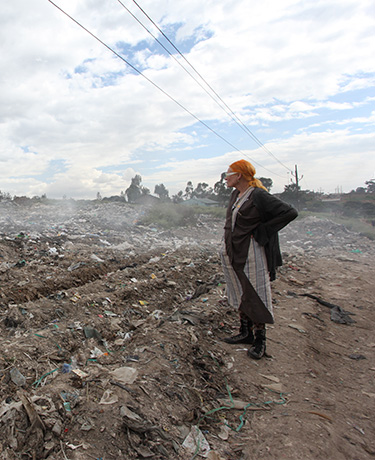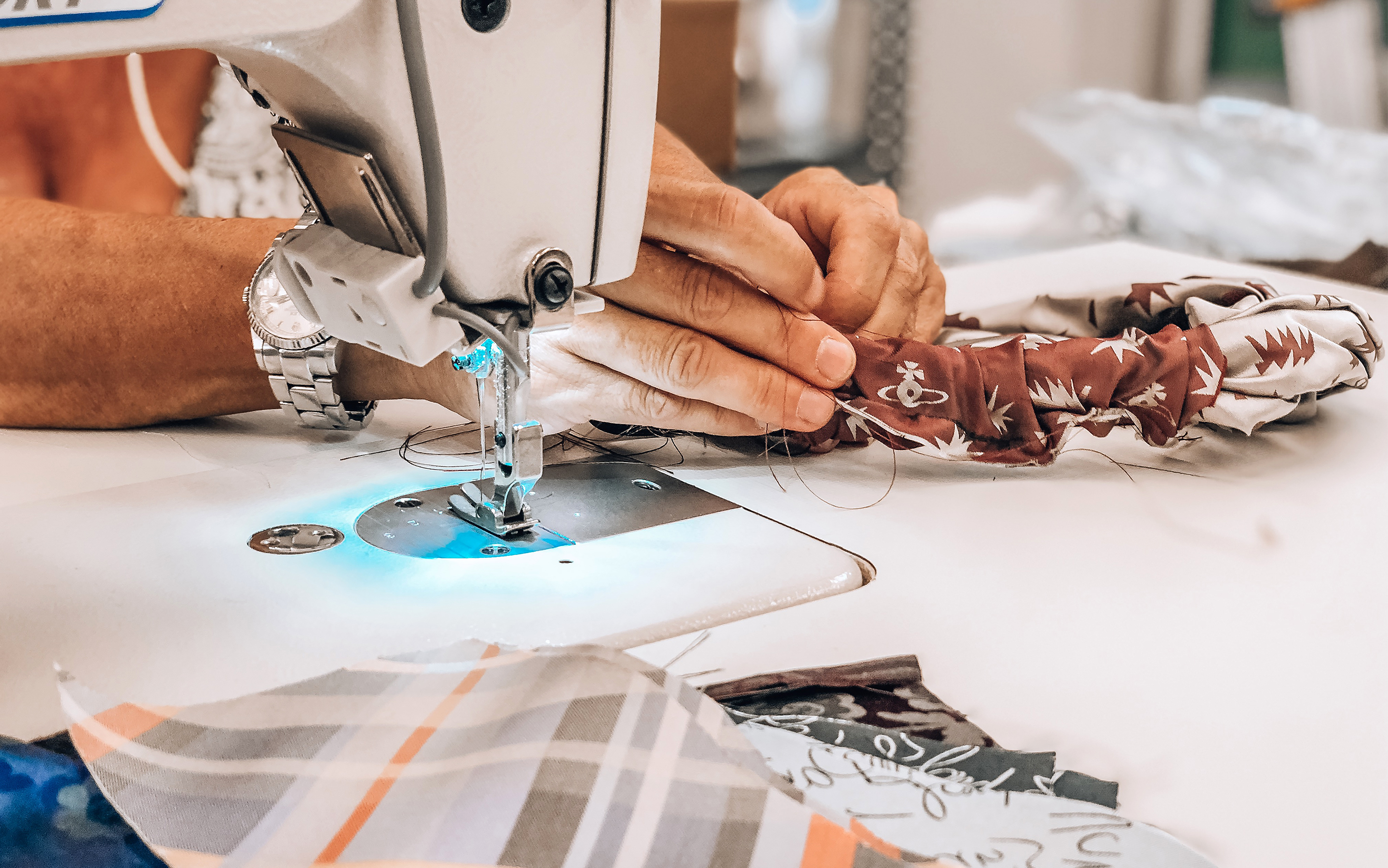We look beyond the aesthetic qualities of the materials we use. As we get a deeper understanding of our supply chain through auditing and traceability activities and projects, we will gain a better understanding of where our materials come from and what impact they may have on the environment and people. All of our direct suppliers are required to complete our sustainability standards. Find out more about our standards, auditing and traceability activities and projects in our Supply Chain section.
Today, over 90% of materials in our Ready-to-Wear collections are made from alternatives we prefer to use based on current industry best practice for their ability to deliver consistently reduced impacts and increased benefits for climate, nature, and people against the conventional equivalent.
Where possible, we trial material innovations, such as leather-like materials made from bamboo or apple skins, which we have used in the past. An 'innovative' material, as the name suggests, is a material or practice/process that is advanced, improved or presents innovative solutions to problems in the fashion industry. This ranges from fibre (example: woven material obtained through textile waste) to dyeing innovations (example: dye obtained from textile waste), and many more.
Each season, our research and development teams actively seek out opportunities to include material innovations in our collections and will continue to do so.
We know the impact the cotton industry has on people and the environment, and we understand this impact varies depending on where the cotton is grown, how it is grown and how it is used as a fibre. As an example, water usage is one of the main issues with cotton production. The European parliament stated in an import report from 2023 that the production of a single cotton t-shirt requires up to 2,700 litres of fresh water, enough to meet one person’s drinking needs for 2.5 years. Other environmentally detrimental practices include, but are not limited to pesticide use and soil degradation from over-production.
In our current RTW mainline collection, where cotton is used the most, over 95% of the cotton we buy is organic (70%), recycled (3%) or from farms with regenerative agriculture practices (12%).
Organic fibres are natural fibres grown without the use of synthetic pesticides, insecticides, or herbicides and GMOs (Genetic Modified Organisms).
We take regenerative agriculture to mean farming practices that revitalise the soil, in order to limit and counteract soil depletion, land degradation and improve the soil’s ability to store carbon.
We introduced poplin made of regenerative agriculture cotton for the first time in 2022, at which point this made up 5% of our cotton offer. In 2023, this has grown to 12% of our cotton offer. Our minimum commitment is to maintain our current offer of cotton grown with regenerative farming practices in place.
Our sustainability, sourcing and development teams are continually following developments in best practice around cotton fibre growing and processing and we are working to understand how our cotton sourcing could best benefit farmers and the environment. Our sourcing and design teams have undergone training around sourcing principles and certifications and we are commencing a traceability pilot to support our efforts to improve our sourcing practices.
The environmental non-for-profit Canopy Planet estimates that annually 3.8 billion trees are logged to make paper packaging and wood-pulp derives fibres such as viscose, rayon and lyocell, threatening the survival of ancient and endangered forests worldwide.
99% of the viscose in our RTW mainline collection has been sourced through forestry guidelines that are environmentally appropriate, socially beneficial and economically viable. By working closely with our suppliers, we aim to maintain this commitment to viscose sourcing, and work to reach 100% with every season.
We have worked with Canopy Planet since 2020, signing their commitment to protecting ancient and endangered forests. You can read more about this commitment here.
Derived from flax, linen requires little to no fertilisers, herbicides or pesticides for growing its fibres and can be fed on rainwater. Our preference is to source linen from the EU for improved traceability and less transportation emissions, compared to linen outside of the EU.
Hemp also requires little-to-no use of fertilisers, herbicides or pesticides, controls topsoil erosion and does not need irrigation. Hemp production can regenerate vital nutrients in the soil and act as a carbon sink – meaning it can absorb more carbon from the atmosphere during its growth than is emitted by the equipment used to harvest, process and transport it.
With every season, our design and fabric development teams are seeking opportunities to include more linen and hemp in our collections, which includes research and evaluation of opportunities during the design and sourcing process.
As part of our goal of eliminating virgin plastic from all our product categories, we are reducing, with a view of phasing out where technically possible ethylene-vinyl acetate (EVA) and synthetic rubber in our shoe soles. Due to the significant need of durability in shoe soles, the maximum amount of recycled content we can include in our sole compositions at the moment is 40%. As this is a complexity of the material itself, we are dependent on wider industry improvements and developments. 74% of our offer of outsoles currently contain natural rubber. Over 30% of our offer of outsoles contain a minimum of 20% and maximum of 40% recycled rubber.
For our AW23 season, 83% of our wool comes from farms that do not practice mulesing (a painful method of protecting certain breeds of sheep from a deadly fly infestation, which involves removing strips of skin).
In 2022, we introduced wool certified by NATIVA™. Every step of the supply chain from farm to brand is certified under the NATIVA™ Protocol. This ensures high levels of animal welfare, farmland-management and the socio-economic welfare of farmers and their communities.
The majority of our NATIVA™ wool comes from farms that take a regenerative approach, focusing on enhancing local ecosystems and strengthening the health, vitality and fertility of farm soil.
Find out more here.
We are deeply committed to our Animal Sourcing Principles that demand care and respect for the animals in our material supply chains. Our Principles are based on the internationally recognised ‘Five Freedoms of Animal Welfare, which include the freedom from hunger and thirst, discomfort, pain, injury or disease, fear and distress and freedom to express normal behaviour. These Five Freedoms of Animal Welfare are a must for all our suppliers to ensure that we do not knowingly use any material or process in our products that inflicts suffering on animals or has a negative impact on biodiversity.
We presently do not use real animal leather in our Ready-to-Wear collections and only use this material for our shoes, bags and small leather goods for its quality and durability. In our current accessories range, animal leather makes up 60% of the whole collection. Our footwear collection is made of 46% animal leather this season.
We require all leather in our products to come from farms with high animal welfare standards, according to our Animal Sourcing Principles. During the sourcing process, our teams check for industry standards suppliers may have in place that can guarantee high levels of animal welfare, and only source materials in accordance with our Animal Sourcing Principles and the Five Freedoms of Animal Welfare. However, due to industry-wide concerns about animal welfare, deforestation and hazardous chemicals used in leather processing, we are reducing the use of virgin animal leather in our accessories and footwear collections, as outlined below.
The alternatives to real animal leather we accept include, but are not limited to, recycled polyester, partially or fully bio-based PU leather or, for our footwear ranges, innovations such as bamboo and apple fibres. If a synthetic material serves to replace an animal leather, our preference is to source a 100% recycled alternative. This way, we eliminate the risks of animal welfare concerns but simultaneously don’t source virgin plastic. Alternatives such as apple fibres can be beneficial as they make use of ‘waste’ materials, for example by utilising discarded apple skins.
We continue to explore alternative materials – such as cactus leather, apple leather, cotton canvas, wool and recycled – in an effort to reduce the amount of leather we use overall.
Silk is obtained from the cocoons of silk worms who feed on Mulberry trees. Silk is a key feature for our bridal collections, making up 40% of all fabrics used for our bridal line. Our sourcing teams are actively investigating alternatives to conventional silk, such as organic or plant-based silk.
The sustainability standards for our Laminated MOP are strictly managed by the New Zealand Ministry for Primary Industries. The Mother or Pearl we use is sourced by Lumea, one of the only fisheries in the world with environmental management standards in place. Lumea carefully manage the complex ecosystems and have measures in place to protect against overfishing and exploitation of the seabeds by involving local communities.
We have been working to reduce virgin synthetic fibres in our products and these now make up less than 30% of the materials in our mainline Ready-to-Wear collection. Our main goal is to maintain this achievement.
Where we are unable to eliminate virgin synthetic materials, we aim for recycled synthetics instead. Currently, 86% of synthetics in our mainline RTW collection is recycled.
In our jewellery collection, we have continuously switched from plastic and resin-based pearls to glass pearls and will continue to work towards replacing all virgin plastic in future collections. In our current collection offer, 15% of our pearls are made of glass, while 21% are synthetic.
While using recycled synthetic materials is good for tackling textile waste, microfibre shedding occurs from washing them so we aim to only use recycled synthetics for garments and accessories that do not require frequent washing and care. We are following research and innovation closely and welcome the proposed measures by the European Commission to restrict microplastics.
All sterling silver in our jewellery collection is recycled. Silver scrap metal from the jewellery manufacturing industry is repurposed by our supplier Umicore in Thailand, who are members of the Responsible Jewellery Council and have been accredited by the LBMA (London Bullion Market Association).
From the Autumn-Winter 2023 collection, we have introduced recycled brass to our jewellery collection. All of our jewellery with brass as main material contain a percentage of recycled brass. All of the brass present in our jewellery collection contains some percentages of recycled brass. Brass has the benefit of being infinitely recyclable but due to quality concerns, it is currently not yet possible for us to have all of our brass 100% recycled.
We are currently testing the feasibility of switching to recycled alternatives for the other metals used in the collection.






